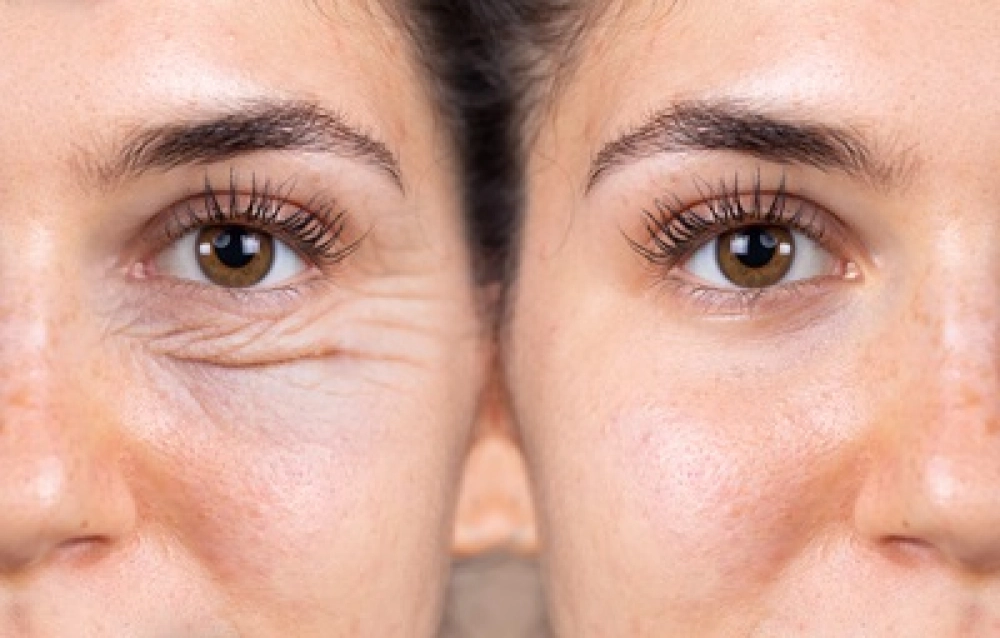
Periorbital Hyperpigmentation - Dark Circles - Tear Trough - Eye Bags
Dark circles and a sunken area under the eyes ("tear trough") can give the face a tired and exhausted appearance, significantly affecting the well-being of those affected.
Photo: © Alessandro Grandini– stock.adobe.com
The under-eye area is a sensitive region prone to shadowing due to its thin skin and is generally susceptible to swelling. Since the pandemic, when the eyes became a focal point due to mask-wearing, the demand for treatments targeting the eye area has increased—interestingly, more men are also seeking these treatments.
-
What types of dark circles are there?
-
What causes dark circles?
-
What treatment options are available?
-
How many treatments/sessions are necessary?
-
What risks and complications are associated with the treatment of dark circles?
-
Are there special laser-procedures for this delicate area?
-
What should I pay attention to after the treatment?
-
How can I book an appointment?
What types of dark circles are there?
Dark shadows and sunken lower eyelids/tear troughs are categorized into different types based on their cause.
Pigmented type (brown tone): Caused by increased melanogenesis in the upper layers of the skin, resulting in brown discoloration around the lower eyelids (often hereditary and more common in darker skin types).
Vascular type (bluish tone): Caused by the visibility of blood vessels, leading to shadows under the eyes.
Structural type (skin tone): Resulting from anatomical depressions due to the retraction of bone structures (congenital, ethnically or genetically predisposed) and fat tissue atrophy.
Mixed types: These include combinations of the above, such as pigment-vascular, pigment-structural, vascular-structural, or pigment-vascular-structural subtypes.
What causes dark circles?
Hereditary discoloration of the lower and upper eyelids ("hyperpigmentation"), which often becomes noticeable in childhood or adolescence, may intensify with age.
Post-inflammatory hyperpigmentation can occur with atopic dermatitis or eczema caused by rubbing and scratching the itchy eye area.
Superficially located blood vessels, covered only by a thin layer of skin, can create a violet tone.
Prostaglandin analogs used to reduce intraocular pressure or promote eyelash growth (e.g., bimatoprost or latanoprost in eye drops) may cause brown discoloration as a side effect.
Factors such as lack of sleep, stress, excessive alcohol consumption, and smoking can exacerbate swelling and shadowing.
What treatment options are available?
Classifying the type and identifying the cause helps determine the appropriate treatment.
To treat brown pigmentation and reduce increased melanogenesis, options include consistent UV protection and creams containing lightening agents (e.g., tranexamic acid, hydroquinone, kojic acid, azelaic acid, arbutin), Vitamin A derivatives (e.g., retinol), or Vitamin C. Chemical peels can increase epidermal cell turnover and remove pigment from the upper layers of the skin (alpha hydroxy acids such as glycolic or lactic acid). Our practice offers specialized peels for the eye area (Peri-Ocular Peeling).
To stimulate collagen production and strengthen the already thin under-eye skin, thereby reducing bluish shadows, vitamins, growth factors (e.g., Platelet Rich Plasma from your own blood, "vampire lift"), non-crosslinked hyaluronic acid, and polynucleotides (derived from salmon germ cells—"salmon sperm") can be injected into the skin. These substances enhance collagen production and can increase skin thickness, concealing bluish blood vessels and lightening dark circles under the eyes.
Structural dark shadows and sunken tear troughs can be treated with fat grafting or hyaluronic acid fillers for infraorbital volume loss. A minimally invasive option for mild eye bags or skin laxity is the fractional CO2 laser. This stimulates collagen production and achieves skin tightening (typically requiring several sessions). For significant skin laxity and shadowing caused by fat deposits ("eye bags"), surgical lower eyelid tightening ("blepharoplasty") is usually indicated.
How many treatments/sessions are necessary?
For minimally invasive treatments (PRP injections, non-crosslinked hyaluronic acid, vitamins, polynucleotides, skin lasers) that stimulate collagen synthesis and activate fibroblasts, multiple sessions (typically 3–4 sessions at 4-week intervals) are recommended. The first results are visible after at least 8 weeks.
For volume deficits treated with hyaluronic acid fillers, usually, only one session (and possibly a follow-up treatment after 4 weeks) is needed.
What risks and complications are associated with the treatment of dark circles?
After injections of the mentioned substances, visible needle spots, bruises, redness, and swelling may occur, especially in the first week after treatment.
Are there special laser-procedures for this delicate area?
COOL TREATMENTS® are a modern series of minimally invasive laser protocols based on the Asclepion Er:YAG laser. They use precisely calibrated parameters to achieve visible and reproducible results — while keeping treatment safe and downtime minimal.
The protocols include, among others, COOL BLEPH for the upper and lower eyelids — a gentle, non-surgical rejuvenation of the eye area.
Their modular design allows combining the laser treatment with additional procedures (e.g. regenerative therapies) to further enhance collagen production and skin renewal.
Thus, for delicate zones such as around the eyes — where you wish for effective rejuvenation but minimal risk and recovery time — COOL TREATMENTS® offer an attractive, safe and efficient option.
What should I pay attention to after the treatment?
Post-treatment care depends heavily on the chosen treatment method. For chemical peels and lasers, consistent sun protection with SPF 50+ is essential. For any type of injection, avoid sports and sauna use on the day of the treatment. Facial massages and other facial treatments should be avoided for two weeks. Detailed aftercare instructions will be provided during the consultation.
How can I book an appointment?
Please select the appointment type "12. Wrinkle Treatment Consultation." This will connect you with the aesthetic experts in our practice. During the appointment, treatment options will be discussed with you, and you will receive comprehensive information about expected results, risks, and costs. The actual treatment will be performed during a second appointment.


